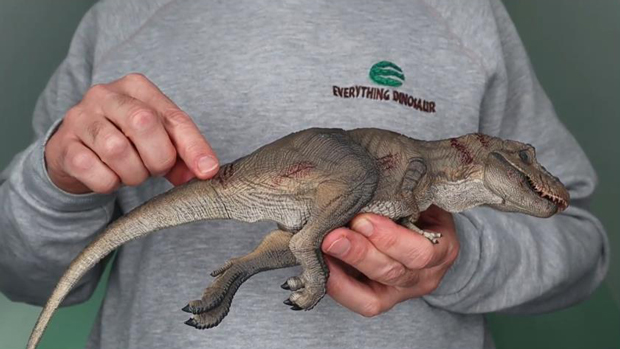New Research into Tyrannosaurus rex “Nosing” Around
Analysis of Tyrannosaur Brain-cases indicates heavy reliance on Sense of Smell
A new study into the composition of theropod brains has just been published in the scientific journal, the British Journal for the Proceedings of the British Royal Society B. It has reinforced the belief that tyrannosaurs relied heavily on their sense of smell. Much work has already been done on the organisation of tyrannosaur brains, primarily from the specimen known as Stan (specimen number BHI3033) discovered in 1992 and now at the Black Hills Institute, South Dakota. A Tyrannosaurus skull is comprised of over fifty separate bones, few complete skulls have been found but with this particular specimen most of the skeletal elements of the skull were discovered and as they were in pieces exquisite details of nerve pathways could be traced. This combined with CAT scans of solid skull fossils have provided palaeontologists with an insight into the functioning of the theropod brain.
Tyrannosaurus rex
In this new study, meat-eating dinosaur brain cases were compared with primitive birds. The research carried out by a team from the University of Calgary in Alberta, Canada were able to examine the indentations made on the inside of the skull bones by various parts of the brain, and from this evidence, work out the size of the individual brain elements. Different parts of the brain are dedicated to different functions. For example, the cerebrum is dedicated towards thinking (a very large portion of our brain is dedicated to this), whereas the olfactory bulb is associated with sense of smell. This new study has helped confirm that 50% of T. rex brain function was dedicated to analysing smells.
Sniffing out his Next Meal – Tyrannosaurus rex Illustration

Picture credit: Everything Dinosaur
An adult Tyrannosaurus rex had a brain that weighed approximately 1 kilogramme, about half of the size of an adult humans but that does not mean that T. rex was half as smart as we are – the size of the body and the arrangement of the functions in the brain have to be considered. From analysis of tyrannosaur brain cases, scientists are aware that predatory dinosaurs had relatively larger brains than their herbivorous contemporaries, in T. rex’s case its brain is bigger than an adult hadrosaur’s and bigger than the brain of an adult Triceratops.
Darla Zelenitsky of the University of Calgary commented:
“Living birds and mammals that rely heavily on smell to find meat have large olfactory bulbs. The same animals also tend to prowl for prey at night, and cover vast areas.”
Examining the Fossil Skull
Of all the dinosaurs examined in this study, the T. rex had the largest olfactory bulb relative to its overall size. This is not surprising as work from the late 1980s and early 1990s undertaken by American scientists had already led to comparison of Tyrannosaurus rex olfactory bulb elements of the brain with that of the Turkey Buzzard (hence the famous line by the Bob Bakker look-alike in the film Jurassic Park 2).
This work may well open up the old debate over whether big predators such as Tyrannosaurus rex were active hunters or scavengers. An excellent sense of smell could help T. rex detect carrion from a distance and then it would have homed in on the carcase to feed. It is likely that most meat-eating dinosaurs would not have passed up the chance of an easy meal and scavenged the remains of dead animals, even other deceased T. rexes.
T. rex skulls also show a large naris, indicating large nasal passages just what you need when you rely on sense of smell. It must also be remembered that there is plenty of evidence to suggest that this large carnivore also had excellent vision, binocular vision and that it could probably see in colour, making this reptile a formidable predator.
To view a model of Tyrannosaurus rex: Dinosaur Models and Toys.
The study also found that primitive birds had high-performance odour detectors, challenging a long-held assumption about the evolution of winged vertebrates.
“It has been previously suggested that smell had become less important than eye sight in the ancestors of birds, but we have shown that this wasn’t so,” said Zelenitsky.
Archaeopteryx, for example, which took to the skies during the Jurassic Period some 150 million years ago, had a sense of smell comparable to meat-eating dinosaurs along with excellent eye sight, the study concluded. Work on the cranial capacity of Archaeopteryx had been carried out by Dr Angela Milner of the Natural History museum in London. Her team’s study demonstrated that this pigeon-sized bird had a brain function that would have given it excellent balance and co-ordination, perhaps indicating that this bird was a better flyer than previously thought.
A Replica of a Tyrannosaurus rex (Rebor T. rex Carcase)

Pointing out the pathology on a T. rex carcass. The Rebor T. rex carcase figure. Picture credit: Everything Dinosaur.
Picture credit: Everything Dinosaur
Somewhere along the way birds began to lose their sense of smell, but the decline probably happened far later than previously thought, this new study concludes.
To view the range of Rebor prehistoric animal models: Rebor Models and Prehistoric Animal Figures.

